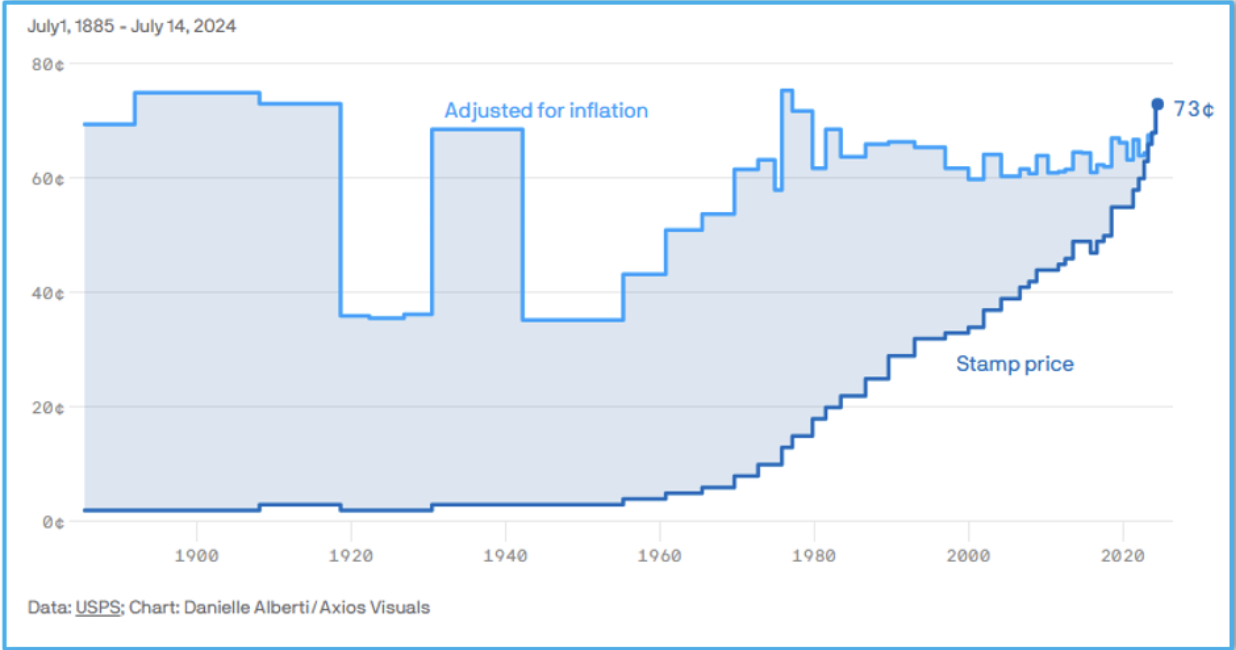Meeting regulatory requirements is non-negotiable for financial services organizations. From privacy notices to late payment reminders, disclosures and notifications by mail remains a key component in ensuring customers receive legally mandated disclosures and important account information on time.
However, relying heavily on physical mail introduces financial and operational challenges—especially as the cost of stamps and postage continues to rise. A 10 Cent increase could mean Millions of dollars in extra costs. This article delves into the various ways postage costs affect compliance mailings, as well as strategies for mitigating these burdens and reducing risk.
The Compliance Mandate: Why Physical Mail Still Matters
Financial institutions operate under stringent regulations governing how and when they must communicate with borrowers and account holders. These communications often include:
- Billing Statements and Invoices
- Interest Rate Adjustment Notices
- Late Payment or Delinquency Letters
- Privacy Policy Disclosures
- Regulatory Disclosures (e.g., Truth in Lending, RESPA)
While digital delivery is becoming more common, some regulations or customer preferences still mandate physical mailing. Certain customer segments lack digital access or decline electronic communications, requiring the financial institution to maintain a robust mailing operation. In addition, some regulators do not fully recognize certain digital communications without formal opt-in processes, resulting in physical mailings remaining the fallback or default method of sending legally required notices.
Stamp Prices and Operational Costs: Where the Dollar Adds Up
When you’re sending a handful of letters, a small increase in postage rates may not seem like a big deal. But in the financial sector, where millions of compliance letters are mailed each year, even a modest postage hike can translate to sizable cost implications.
1. Postage Rate Increases
- Forever Stamp Dependence: A 1 oz First-Class Mail letter in the U.S. currently costs around $0.66 per stamp (as of late 2023 / early 2024). Every time the USPS increases its postage rate by a few cents, institutions with high-volume mailings see immediate and sometimes staggering surges in their annual mailing budget.
- Additional Ounce Fees: If the weight of the mail piece exceeds one ounce (for instance, statements with inserts or multi-page disclosures), additional ounce fees push costs higher.
2. Large-Volume Mailings
- Exponential Cost Growth: Financial organizations that send thousands or millions of envelopes each month face exponential postage cost growth. This can quickly erode profit margins if not factored into long-term budgeting.
- Bulk Mailing vs. Retail: Some lenders utilize bulk mailing rates for high volumes, but these also experience periodic price increases. While bulk mailing lowers costs per letter, it still ties operational costs directly to postage.
3. Administrative Overhead
- Staffing and Logistics: Managing large mail volumes requires administrative staff to process, print, sort, and apply postage. Institutions spend considerable labor hours ensuring each correspondence is properly addressed and meets compliance deadlines.
- Rework and Reshipping: If mail is returned or mislabeled, additional postage is required for resending. Compounding these mistakes leads to wasted staff hours and more postage costs.
Compliance Risk Amplified by Rising Mailing Costs
The pressure to maintain compliance deadlines doesn’t disappear just because postage rates rise. If anything, higher costs can make it tempting to delay or batch mailings in ways that might jeopardize timely delivery. Some institutions might underestimate volume projections or push mailings closer to deadlines, risking late delivery and subsequent fines or legal repercussions.
- Delayed Notices: Missing mailing windows for legally required notices—such as adverse action letters or rate change notifications—can result in regulatory scrutiny and fines.
- Audit and Record keeping: Financial services must maintain proofs of mailing for compliance tracking. As volumes grow, so do storage requirements for physical records, increasing operational costs further.
Strategies to Mitigate Postage Costs
1. Move Toward Digital Correspondence
Benefits:
- Cost Savings: Eliminating or greatly reducing physical mail can slash paper, printing, and postage expenses.
- Instant Delivery: Email or secure portals deliver compliance documents more quickly than traditional mail, potentially speeding up the lending or servicing process.
- Audit Trail and Tracking: Digital platforms create instant records of sent communications, making compliance audits more straightforward.
Challenges:
- Regulatory Approval: Some forms of digital communication require explicit customer opt-in. Financial institutions must ensure they have the right to deliver certain disclosures electronically. The good news is many disclosures allow electronic delivery with delivery confirmation. Look for solutions like Lightico that can provide a legal audit trail and allow for customers to acknowledge receipt, such as obtaining an e-Signature.
- Customer Adoption: Not all customers are comfortable with or capable of receiving electronic notices. Physical mail may remain a necessity, at least for a small subset of accounts.
2. Optimize Physical Mailing Processes
Bulk Mailing Discounts:
- Presorting and Automation: Working with mail service providers can reduce costs by leveraging presort discounts and other postage-reducing tactics.
- Consolidated Mailings: Combining multiple notices into a single envelope when permissible can reduce the number of total mail pieces.
Data Cleansing:
- Address Verification: Keep mailing lists up to date to reduce returned mail and rework. Integrated address validation tools can limit undeliverable mail, saving both time and postage.
- Targeted Correspondence: Sending fewer but more meaningful mail pieces can reduce overall volume (for instance, only sending inserts or additional pages when absolutely required by regulation or customer need).
3. Hybrid Approach
Adopting a hybrid model—digital-first for consenting customers and physical mail for those who must or prefer to receive paper notices—can strike a balance between cost savings and compliance coverage. By aggressively promoting digital enrollment, financial institutions can shrink their base of paper recipients over time, mitigating the impact of postage increases.
Best Practices for Cost-Efficient Compliance Mailings
- Stay Updated on Postal Rates
Monitor USPS announcements for upcoming rate hikes. Build postage fluctuation forecasts into annual budgets to avoid surprise costs. - Automate Where Possible
Consider software that automatically generates and tracks compliance communications. This reduces labor overhead and ensures consistent, prompt mailing according to regulatory timelines. - Centralize Compliance Oversight
Having a dedicated compliance operations team or centralized mailing system helps maintain uniform processes and ensures timely, accurate dispatch of required notices. - Encourage Digital Opt-In
Offer incentives (like faster access to account updates or e-statements) to motivate customers to switch to electronic communications.
Conclusion
Physical mail remains integral to compliance for many financial organizations, but the rising cost of postage poses a growing challenge. Relying on stamps to fulfill regulatory requirements can significantly strain budgets, especially for high-volume mailings.
By embracing digital correspondence via technology like Lightico, and exploring cost-saving measures such as bulk mailing discounts, data cleansing, and automation, financial institutions can reduce their stamp dependency and free up resources for other strategic priorities.
As consumer preferences increasingly tilt toward digital engagement and sustainability becomes a corporate priority, the shift toward digital correspondence is more compelling than ever.



